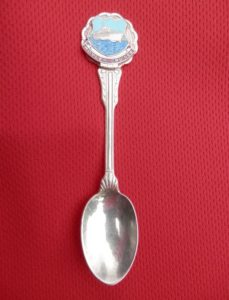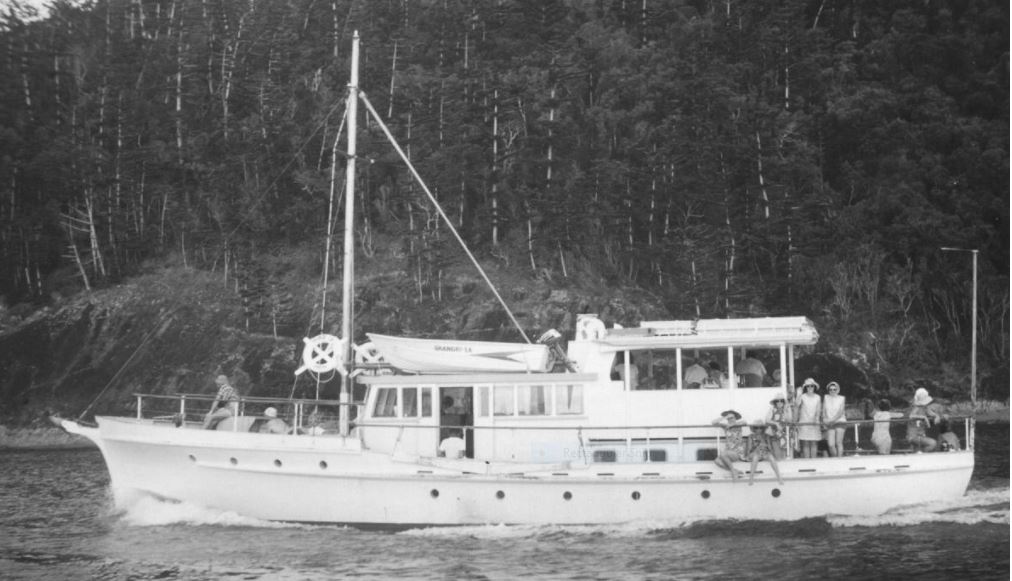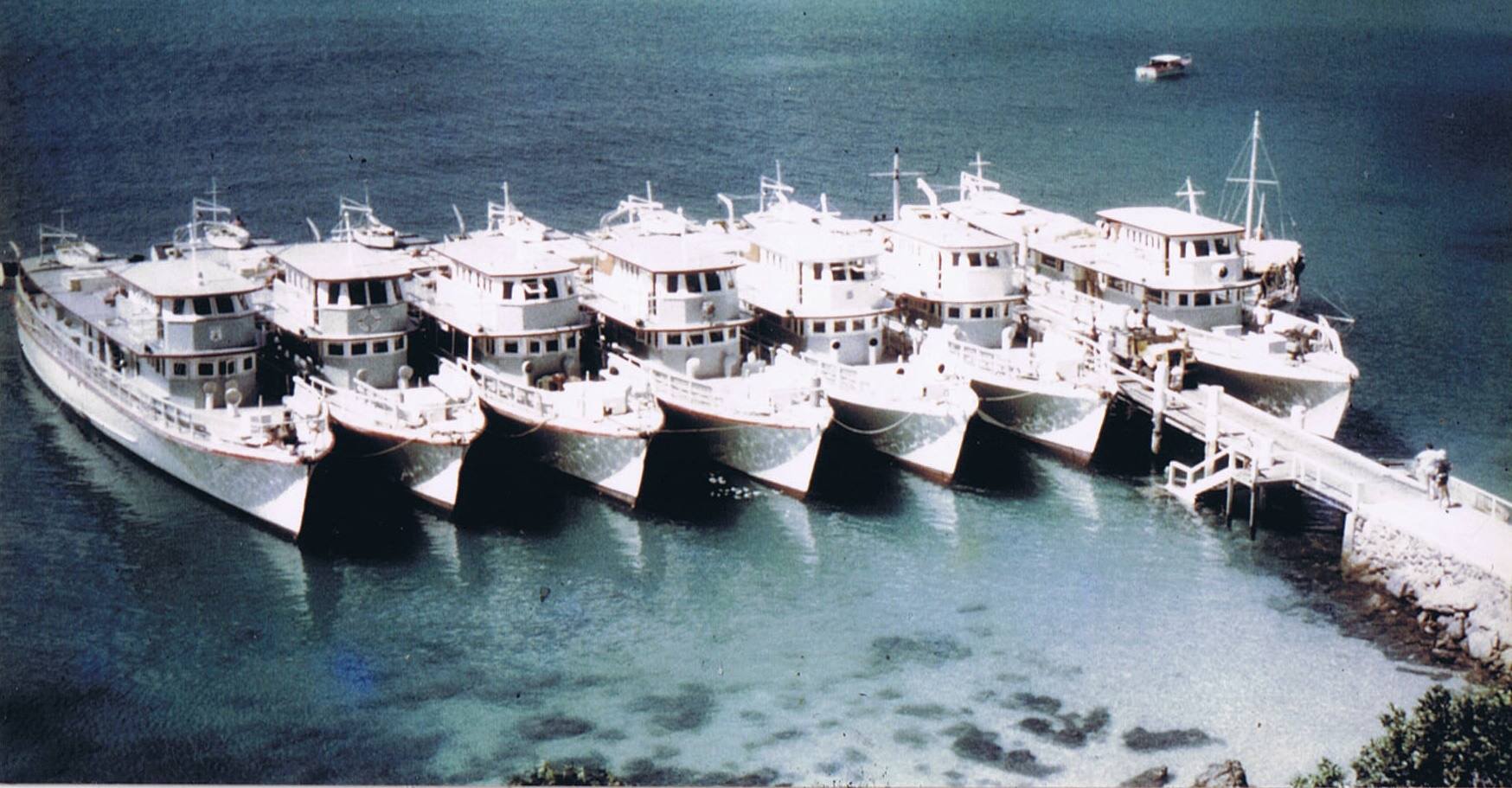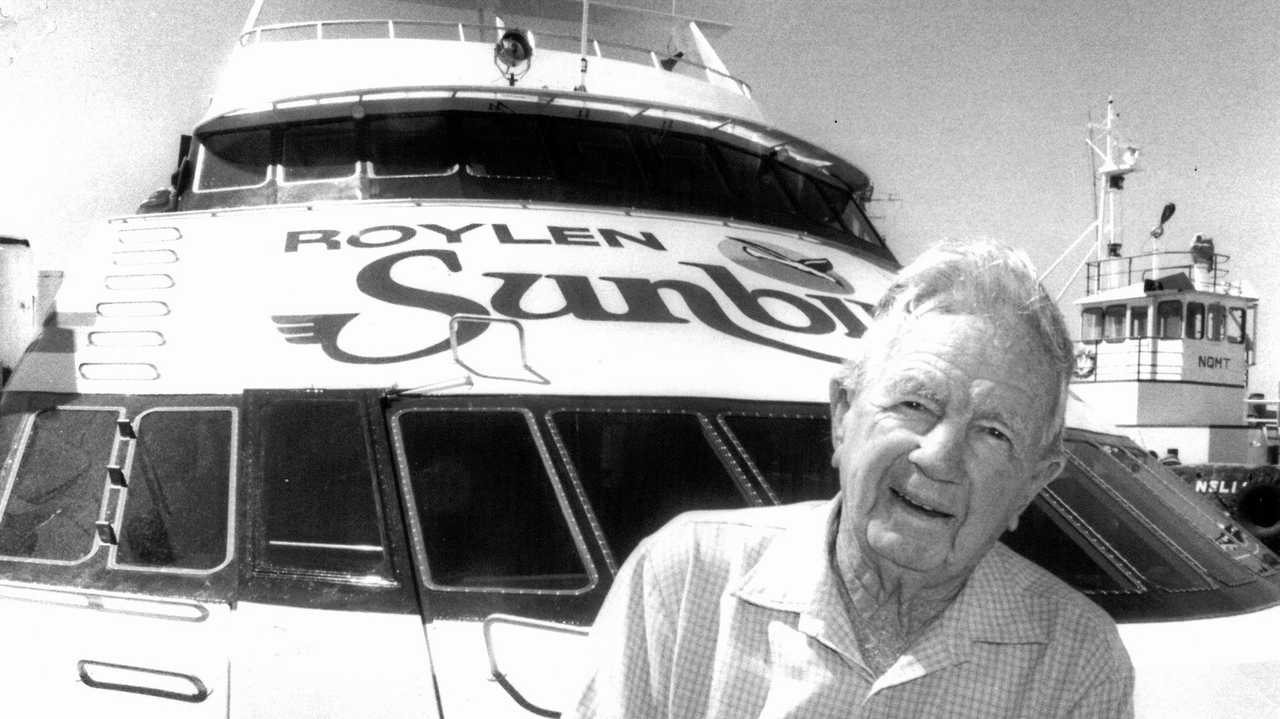- Author
- A.N. Other
- Subjects
- Ship design and development
- Tags
-
- RAN Ships
- None noted.
- Publication
- December 2021 edition of the Naval Historical Review (all rights reserved)
By Walter Burroughs
A visit to an Opportunity Shop browsing through other people’s junk is often time wasting. And so it was while wasting time that an unwanted, ubiquitous, one-dollar souvenir spoon came into view. It was good quality, with a crisp enamelled outline of a small ship that looked vaguely familiar. The prize was a 1960s souvenir of Roylen Cruises, from which the following story arises of possibly the world’s largest privately operated fleet of ex-wartime motor launches. Coincidentally, we stumble across the beginning of the pioneering Queensland tourism industry.
George Thomas McLean, always known as Tom, was born on 12 December 1901 at Mount Morgan, Queensland, the second of eleven children of George Weston McLean, and his wife Annie, neé Redhead. Tom attended Cawarral State School, for four years—his entire formal education. His father moved the family frequently, trying various rural pursuits interspersed with hotel ownership and mining. When Tom was sixteen, his father built a store at Dululu, near Mount Morgan, which Tom ran single-handedly for several years. In 1923 McLean senior bought two cane farms in the Mackay region; Tom and his brother Perce managed them. On 6 April 1932 Tom married Helen (Nell) Bell Braithwaite whose parents were local cane farmers. Tom had purchased a small cane farm of his own, near Calen, and the couple moved there and survived the Great Depression.
It was at this time that Tom’s love of the sea first came to the fore. Having spent five shillings (50c) on a book of boat plans he was on his way. He selected a suitable tree, had it felled, sawn, and with the timber cured he built his first boat, Dorothy, 24 feet 6 inches (7.5 m) in length. Reluctantly Tom parted company with her in 1938, when he became the proprietor of the Proserpine Hotel. Dorothy spent the next 20 years as a training ship for the local sea cadets.

Two years later Tom sold the Proserpine Hotel and bought the lease of the nearby Metropole Hotel. Always interested in politics, he was a member of the Proserpine Shire Council and in 1940 unsuccessfully contested the Legislative Assembly seat of Bowen for the Australian Country Party.
Tom McLean recognised the opportunity for a cruise service to the Great Barrier Reef and the islands of the Whitsundays, but his plans were thwarted by the outbreak of World War II. Lowering his age by three years, on 23 April 1942 he enlisted in the Australian Imperial Force (AIF). He served in New Guinea with the 2/2nd Docks Operating Company and in Queensland with the 5th Advanced Reinforcement Depot, reaching the rank of sergeant. During his service in New Guinea Tom noticed the graceful lines of Shangri-La, a motor cruiser flying the Stars and Stripes, and numerous fast motor launches flying the White Ensign, crewed by adventurous young Australians.
The beginning: MV Shangri-La
Shangri-La was a 57 foot (17.3 m) luxury sail and motor cruiser built in Sydney for Harold Arnott of biscuit making fame. She was launched in 1938 and with the outbreak of war was donated to the Commonwealth and allocated to the New South Wales Volunteer Coastal Patrol Service. She was later purchased by the United States Army Small Ships Section as a headquarters vessel.
In July 1942, under command of New Zealander Ralph Andrews with an American Filipino crew, Shangri-La sailed for Brisbane where General MacArthur had relocated his headquarters and had a riverside residence, the vessel being used to ferry the great man as required. She later proceeded to New Guinea, where she saw some war service but was mainly used as a hotel for visiting senior officers; eventually she accompanied the fleet train to the Philippines. At the end of hostilities, she was freighted back to Sydney.
Following his discharge from the Army in April 1945 Tom rekindled his interest in the tourism industry and the next year he was very busy. After moving to Mackay and qualifying as a master of coastal vessels it was off to Sydney on the lookout for potential cruise vessels. Tom found Shangri-La for sale and bought her for £2,350. Following an initial refit at Rushcutters Bay, Tom and some friends sailed her to Mackay for further improvements to increase her passenger capacity. She was also used to tow newly acquired glass-bottom boats onto the Great Barrier Reef. Then started a period of three-day tourist cruises. With the start of Roylen Cruises the lease of the Metropole Hotel was sold, leaving the family to concentrate on the cruise business.
Shangri-La was a fine vessel which attracted a small number of passengers at the luxury end of the market. Reg Ansett (later Sir Reginald), the owner of Ansett Airlines, became a client; he was later to develop a large resort on Hayman Island. But Tom needed to expand into a larger market and for this he needed bigger vessels. After only two years of service and still in first class condition Shangri-La was sold to the Lindeman Island Company, replaced by the larger MV Roylen.

A Fleet of Fairmiles
In the early days of WWII, the Royal Australian Navy (RAN) was desperately short of small patrol vessels for use incoastal waters, primarily in the anti-submarine role. Accordingly, 20 prefabricated wooden Fairmile Type B Motor Launches (MLs) with their armament and engines were shipped from Britain. The first eight boats from the 400 series of hull numbers were originally destined for Singapore but with the dramatic fall of that fortress they were redirected to Australia. These craft were assembled at the purpose-built Green Point Naval Boatyard at Mortlake on the Parramatta River – the first of these vessels to commission into the RAN was ML 424. A further 15 vessels were built by local boat-builders Lars Halvorsen on the opposite shore of the Parramatta River at Ryde, and Norman Wright at Bulimba on the Brisbane River. Interestingly, Halvorsen built the Fairmiles at a competitively attractive fixed price of £21,750 per vessel (lower than UK and Canadian yards), including the fitting of supplied armament and machinery, whereas the other builders quoted on a cost-plus basis.
The Australian Army also took a liking to Fairmiles and ordered three variants of the Type B vessels. There was one cancellation so only two were built by Halvorsens as unarmed specialist target towing craft. These boats, AV 2769 and AV2770, entered service in July and August 1946. They operated AV 2769 from Fremantle and AV 2770 from Sydney and both remained in service until the 1960s. They were known by the unmilitary-like names of Maureen (AV 2769) and Sandra (AV 2770).
The motor launches were augmented by a further 28 similar, but smaller, Harbour Defence Motor Launches (HDMLs) mostly supplied from the United States (16) and Britain (3) shipped as deck cargo, but nine boats were also constructed at various local Australian yards. In total 63 Fairmile type ships were commissioned into RAN service and surprisingly these wooden-hulled vessels were the largest number of any one class in the Navy’s strength at the end of WWII. Not forgetting the two Army vessels mentioned above, so a grand total of 65 Fairmiles was constructed.

While these naval vessels were commissioned they were not dignified by names but by hull numbers such as ML 805or HDML 1321. MLs had a loaded displacement of 75 tons, were 112-feet long with a 17 foot 10 in beam and a draught of 5 feet 4 ins. They were powered by two Hall Scott petrol engines giving a speed of 20 knots. The initial armament was 1 x 2 pdr gun, 1 x 20 mm and 4 x 0.303 machine guns and 2 x depth charge throwers. They had a complement of 16 officers and men. To improve habitability, the Australian variant of the smaller HDMLs was 80-feet long, whereas the US and British built vessels were only 72 feet long (deemed the largest size that could be shipped as deck cargo). The US and Australian HDMLs were powered by diesel engines, but their British counterparts used petrol engines. Two vessels were lost during WWII and post-war some were retained in naval service and others returned to the United States, but most MLs were sent to auction in 1947-48 at Brisbane, Fremantle and Sydney. Of these, 20 had their engines removed and five others were sold complete with engines. They ranged in price from a low of £145 to a high of £2,750 (with engines). The lack of engines suited most buyers as the original petrol driven variety were uneconomical and considered a fire risk. The engines were replaced with diesels, some of which were surplus from naval stores, coming from HDML stocks.
Roylen Cruises
Hearing that some Fairmiles were up for sale in Brisbane, Tom went on an inspection in late 1947 and met Jim Douglas who was in the process of converting ML 424; they came to an agreement and Tom bought her for £1,500 and named her Roylen, from the names of two of his children, Fitzroy and Helen.
In converting her for cruising the superstructure was raised to enhance the profile and increase the passenger capacity to 24. The 600 hp Hall-Scott petrol engines were replaced by two economical ex-HDML 150 hp Hercules diesels bought from Naval disposals at 1,000 each, providing a speed of about 10 knots. To overcome these changes and improve stability two tons of ballast went into the bilges.
After all this work the Queensland Department of Harbours and Marine would not allow Tom to use the vessel because she was over 50 tons. ‘I was so dejected I went to a nearby pub to drown my sorrows. There I bumped into the Commonwealth surveyor, Captain James Heard. By making examinations and deductions, he surveyed her at 49.9 tons, and Harbour and Marine accepted the survey’.
Roylen began cruising in the spring of 1948 with a new five-day cruise format which proved popular with family groups and there was a need for further expansion. The Fairmile Cruising Company had two ex-navy vessels Comorinand Fairmile Corsair. Tom was able to purchase the first of these and in 1949 she joined the fleet as Roylen II.
Tom went to Tasmania in 1950 looking for suitable vessels to add to his fleet. The famous local jam making company IXL was seeking to dispose of its four elderly coal burners, and forever seeking a bargain, Tom struck a deal. He originally intended sailing them to Queensland but instead decided on a second venture and McLean’s Derwent River Cruises was born. Hampered by what he perceived to be official obstruction to his setting up in competition with local operators and not enjoying the climate, the venture was not as successful as was hoped. Two years later Tom sold the business and returned to Mackay.
Returning, possibly somewhat chastened, from the Apple Isle it was back to business on the Sugar Coast. A third boat, ML 809, was being converted to tourism by C. Patterson of Cairns Plywood Pty Ltd. She was acquired in 1952 and became Roylen Star. Next came Roylen Vianne from the shipping agents Robert Milne Gow & Co of Brisbane. A Sydney based vessel named AWA was renamed Roylen IMF. An ex-Australian Army vessel AV 2770, handsomely painted with a green hull, had briefly served as Reef Encounter when bought at public tender. She was a beautifully maintained ship, army service not having the same harsh operating environment as naval vessels had encountered. She became Roylen Sandra.
ML 810 which had been named Ajax was also well fitted out and had two large CAT diesels giving her a speed of 16 knots. She became Roylen Petaj and was primarily used for upmarket guests.
The last fully operational ML acquired by Roylen was found locally, bought as Lester E from Jim Diplock of Mackay in May 1961. She had had a harsh life; with sister ships Byrond I and Byrond II had served with the Byron Bay Whaling Company catching whales off the northeast coast of New South Wales and Norfolk Island. She required a lot of work and it was not until 1965 that she joined the fleet as Roylen GT. Byrond I became Ataluma of the Australian Hydrographic Service.
ML 816 was acquired but in poor repair and she was only used for spares. She was given the nickname Greenie. The tenth and last ML of the Roylen Company was the ex-Tambo Princess and Daydream. In 1970, shortly after her transfer to Roylen and renamed B J Dean, she was severely damaged by Cyclone Ada and was never used as part of the cruise fleet.
In the holiday season the Roylen fleet made an impressive sight with six or more pristine white hulled cruisers setting off in best naval precision from Mackay on Tuesday mornings for Brampton Island some 22 nautical miles (40 km) distant over sparkling clear blue waters. They would return home together on Saturdays.
Royal Patronage
Princess Alice, the Countess of Athlone, was a great traveler who in 1959 embarked in a cargo ship, Queensland Star, to visit her daughter Lady May Abel Smith, the wife of Queensland’s Governor Sir Henry Abel Smith. During this time, she visited the Great Barrier Reef, becoming the first royal customer of Roylen Cruises. Prince Charles, who was a 17-year-old student at Geelong Grammar School’s Timbertops campus, visited north Queensland in July 1966. This included a cruise of the Great Barrier Reef when Roylen Petaj, commanded by Fitzroy McLean, was chartered for the royal visitor and entourage from 15 to 18 July 1966.
In December 1969 Tom McLean received an imposing looking letter from the Flag Officer Royal Yacht, Rear Admiral Sir Patrick Morgan, KCVO, CB, DSC, seeking his advice on suitable anchorages for the Royal Yacht Britannia during a visit planned for April 1970. A few day’s respite was planned for the Royal family on a Barrier Reef island away from the maddening crowds. Tom was asked to keep this information confidential. In response Tom nominated Scawfell and Bushy Islands as likely suitable anchorages.
A few days before Britannia was due at Mackay, Tom was invited to Brisbane, and at a presentation onboard the Royal Yacht he received an MBE from Her Majesty for services to tourism. On the day that Britannia was due at Mackay the weather turned foul and the ship anchored off while her escort HMAS Stuart entered harbour to uplift the Royal family who had flown from Brisbane to Mackay. Tom also embarked in Stuart as an adviser and the next day when the weather abated they anchored in Refuge Bay off Scawfell Island where the family could have some R&R on their own desert island.
Australian Hydrographic Services
David Williams, now domiciled many miles from the sea in Wagga, is a retired Warrant Officer who spent some time as a young stoker serving in the demanding MLs. This experience became invaluable when in civvy street he was recruited by Australian Hydrographic Services Pty Ltd (AHS).
The Hydrographic Branch has always been a bit of a ‘navy within a navy’ and in the early 1960s a group of ‘droggies’ took this one step further and formed AHS with the aim of contracting services back to the Hydrographic Branch. To achieve this, they needed experienced staff and a suitable ship.
Two MLs were acquired by the Byron Bay Whaling Company in the early 1950s and taken to the Ballina Slipway and Engineering Company for conversion to whale chasers. One of these is known to be ML 807 and the other is believed to be her sister ML 808. In their new role they were renamed Byrond I and Byrond II and operated from shore stations off Byron Bay and Norfolk Island. The venture was unprofitable and by the early 1960s closed with both ships being on-sold.

Byrond I was acquired by Australian Hydrographic Services and refitted for surveying again by the Ballina Slipway and started her new life as MV Ataluma in 1963. David Williams stood by her in Ballina and remained with the ship until 1971. During that period neither he or any of his shipmates could find a plaque or other fitting to confirm that she was indeed ML 808. David says that her crew was almost exclusively ex-RAN and predominately from the Hydrographic Branch with an ex-naval survey officer in command.
In concert with National Mapping a major survey for bathymetric data supply took them to the north of the continent from 1971 to 1974. During this period, she was commanded by Commander Hugh Vaughan RN.
Early in 1974 Ataluma ran aground and suffered some structural damage and as her survey days were numbered, most vital equipment was removed. During Cyclone Tracy she was moored with another vessel in Darwin Harbour. Unable to start her engines she was allowed to ride out the storm, resulting in the two vessels smashing into one another and they were destroyed and sank on 24 December 1974. There was no loss of life.
Byrond II was first resold in 1961 and eventually ended up with Roylen Cruises but in a poor state of repair; it was not until 1965 that she began cruising as Roylen GT. While at sea in November 1984 she caught fire and sank. Luckily there was no loss of life.
Later Developments
As the business expanded and more Fairmiles joined the fleet the company acquired a large warehouse complex on the Pioneer River and used it as offices, a workshop and slipway. Again with expansion members of the next generation of the family joined the firm, with most of three generations of the family being involved on the boats or at Brampton Island. In 1962 the business purchased Brampton Island for £80,000 to use as a destination for day trips and as an accommodation option for passengers on five-day cruises. The McLeans undertook a major refurbishment and expansion of the island’s facilities, including a deep-water jetty, a miniature railway to service it, and an airstrip.
By the late 1970s it was recognised that the ageing Fairmiles could not cope with the demand, so the family commissioned four large catamarans and, for viewing coral, a semi-submersible. The Fairmiles were sold and the first replacement in 1979 was Roylen Endeavour, purpose built by Carrington Slipway of Newcastle. In 1983 a second cat, Spirit of Roylen, was built by International Catamarans of Hobart. The final vessels to enter the Roylen passenger fleet were Roylen Sunbird (1987) and Roylen Endeavour II (1988) built by North Queensland Engineering Agents at Cairns.
Generous and community minded, Tom McLean donated holidays on Brampton Island as prizes to assist local fund-raising efforts. He took an active interest in the welfare of ex-servicemen and had presided over the Proserpine sub-branch of the RSL. The publication of his autobiography, Captain Tom (1986), fulfilled a long-held ambition. Years after he retired from the sea, he could still be seen around the region dressed in immaculate captain’s whites.
On 04 August 1976 a function was held at Lindeman Island to celebrate 30 years of the tourist industry in Queensland. The then premier Joh Bjelke-Petersen travelled to the island in Shangri-La and made a memorable speech noting the fact that the four-billion dollar Queensland tourist industry which employed 11 percent of the state’s workforce started with Shangri-La. He praised her indispensable and pioneering role. Perhaps the premier might have mentioned that none of this would have happened without the vision and determination demonstrated by Tom McLean.
Tom McLean died in Mackay on 17 February 1994. His wife Nell had died two years earlier but their two daughters and one of their two sons survived him. Tourism to the reef and islands became a major industry in the Whitsunday and Mackay regions. In 1985 they sold Brampton Island to Trans-Australia Airlines to concentrate on cruising. McLeans Roylen Cruises Pty Ltd ceased trading in 2009.
At its peak 14 Fairmiles were working out of the Whitsundays; of these ten belonged to Tom McLean, being the largest privately owned fleet of ex-naval ships in the Commonwealth. Tom McLean was definitely not alone in recognising the virtues of Fairmiles; both the now well-known companies Captain Cook Cruises and Coral Expeditions Australia started their companies each with a single Fairmile.
Finale
Hopefully readers will agree that a little time-wasting and a small outlay was time well spent.
Names of the fleet:
The names were all derived from the McLean family. Roylen is derived from the names of two of their children, Fitzroy and Helen. Vianne was named after their second daughter, IMF was from the initials of grandsons Ian, Mark and Fitzroy and Sandra was Vianne’s middle name. Tom’s initials were G T and B (Barry) J Dean was their son-in-law. The strangely namedPetaj had the first three letters for (Peter) the son of Fitzroy McLean and the last two from Ajax (the vessel’s previous name), it being considered unlucky to completely change a ship’s name. Greenie was the vessel’s name when acquired and had not been changed.
Appendix: The Roylen Fleet
| Roylen Cruises | Previous Name | Acquired | Comments |
| Shangri-La | Shangri-La | 1946 | Sold 1948 – 10 pax |
| Roylen | ML 424 | August 1947 | Sold 1972 – 24 pax |
| Roylen II | ML 818? (ex Mareeba& ex Comorin) | 1949 | Sold 1969 |
| Roylen Star | ML 809 | 1952 | Sold 1979 |
| Roylen Vianne | ML | 1958? | Wreck Cyclone Kerry 01 March 1979 |
| Roylen IMF | ML 805? (ex AWA) | Gift to Sea Scouts 1979 | |
| Roylen Sandra | ML AV 2770 | 1962 | Sold 1982 |
| Roylen Petaj | ML 810 (ex Ajax) | 1960 | Sold 1979 |
| Roylen GT | ML 807 (ex Byrond II) | May 1961 | Destroyed by fire Nov 1984 |
| Greenie | ML 816 | August 1949 | Reserved for spares |
| B J Dean | ML 812? (ex Tambo Princess & Daydream) | 1970 | Reserved for spares – sold 1985 |
| Roylen Endeavour | Cat – 530 grt | 1979 | Sold – 200 pax |
| Spirit of Roylen | Cat – 277 grt | 1982 | Sold, now Reef Magic 11 |
| Roylen Sunbird | Cat – 160 grt | 1987 | Sold – |
| Roylen Endeavour II | Cat – 684 grt | 1988 | Sold – 250 pax |
References
Davis, Colleen, The Fairmiles, Australian Sea Heritage, Sydney Maritime Museum, 1986.
Evans, Peter & Thompson, Richard, Fairmile Ships of the Royal Australian Navy Vols. 1 & 2, Australian Military Publications, Sydney, 2005.
Maclean, Hilda E., George Thomas (Tom) McLean, Australian Dictionary of Biography, ANU, 2021.
McLean, G. T., Captain Tom, Boolarong Press, Brisbane, 1986.
Pocock, Celmara, Anne, PhD thesis, Romancing the Reef; history, heritage & the hyper-real, James Cook University, December 2003




